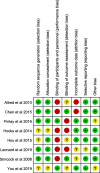The effect of musical interventions in improving short-term pain outcomes following total knee replacement: a meta-analysis and systematic review
- PMID: 33036637
- PMCID: PMC7547446
- DOI: 10.1186/s13018-020-01995-x
The effect of musical interventions in improving short-term pain outcomes following total knee replacement: a meta-analysis and systematic review
Abstract
Background: A growing number of patients continue to receive total knee replacement (TKR) surgery. Nevertheless, such surgeries result in moderate to severe postoperative pain and difficulty in managing it. Musical interventions are regarded as a type of multimodal analgesia, achieving beneficial results in other clinical treatments. This study aims to evaluate the effect of musical interventions in improving short-term pain outcomes following TKR in order to determine a more reasonable and standard way of delivering musical intervention.
Methods: A systematic search was conducted to identify available and relevant randomized controlled trials (RCTs) regarding musical interventions compared against non-musical interventions in patients treated with TKR in Embase, MEDLINE, Cochrane Library, Web of Science, CNKI, and Wanfang Med Online up to 8 January 2020. The authors independently assessed study eligibility and risk of bias and collected the outcomes of interest to analyze. The statistical analysis was conducted using the Review Manager (RevMan) version 5.30 software.
Results: Eight RCTs comprised of 555 patients satisfied the inclusion criteria and were enrolled in the present study. The results showed no significant difference between the music and control groups in pain of the visual analog scale (VAS), during postoperative recovery room, back to the ward after surgery; anxiety degree of VAS; heart rate; respiratory rate; oxygen saturation; blood pressure, systolic blood pressure, and diastolic blood pressure. Nevertheless, significant differences were observed between the two groups in average increase in continuous passive motion (CPM) angles and LF/HF ratio (one kind index of heart rate variability).
Conclusions: Musical interventions fail to demonstrate an obvious effect in improving short-term pain outcomes following TKR. A reasonable standardization of musical interventions, including musical type, outcome measures used, outcomes measured, duration, timing and headphones or players, may improve pain outcomes with certain advantages and should be further explored after TKR.
Keywords: Knee surgery; Meta-analysis; Music interventions; Music therapy; Pain; Systematic-review; TKA; TKR; Total knee replacement.
Conflict of interest statement
The authors declare no competing interests.
Figures











Similar articles
-
Physiotherapy rehabilitation after total knee or hip replacement: an evidence-based analysis.Ont Health Technol Assess Ser. 2005;5(8):1-91. Epub 2005 Jun 1. Ont Health Technol Assess Ser. 2005. PMID: 23074477 Free PMC article.
-
The Effect of Music on Postoperative Agitation, Pain, and Opioid Use among Patients Undergoing Total Knee Replacement.Pain Manag Nurs. 2024 Dec;25(6):571-575. doi: 10.1016/j.pmn.2024.04.009. Epub 2024 May 7. Pain Manag Nurs. 2024. PMID: 38719659
-
The Effect of Music Listening on Pain, Heart Rate Variability, and Range of Motion in Older Adults After Total Knee Replacement.Clin Nurs Res. 2019 Jun;28(5):529-547. doi: 10.1177/1054773817749108. Epub 2017 Dec 18. Clin Nurs Res. 2019. PMID: 29254373
-
Combining various acupuncture therapies with multimodal analgesia to enhance postoperative pain management following total knee arthroplasty: a network meta-analysis of randomized controlled trials.Front Neurol. 2024 Mar 18;15:1361037. doi: 10.3389/fneur.2024.1361037. eCollection 2024. Front Neurol. 2024. PMID: 38562427 Free PMC article.
-
Are perioperative interventions effective in preventing chronic pain after primary total knee replacement? A systematic review.BMJ Open. 2019 Sep 6;9(9):e028093. doi: 10.1136/bmjopen-2018-028093. BMJ Open. 2019. PMID: 31494601 Free PMC article.
Cited by
-
Exploring the use of music to promote physical activity: From the viewpoint of psychological hedonism.Front Psychol. 2023 Jan 25;14:1021825. doi: 10.3389/fpsyg.2023.1021825. eCollection 2023. Front Psychol. 2023. PMID: 36760458 Free PMC article.
-
Effects of Five-Element Music Stimulation in Perioperative Period on Sleep Status and Psychological Regulation in Patients Undergoing Orthopedic Surgery.Noise Health. 2024 Jul-Sep 01;26(122):403-409. doi: 10.4103/nah.nah_77_24. Epub 2024 Sep 30. Noise Health. 2024. PMID: 39345084 Free PMC article.
-
Bilateral heterotopic ossification following Total knee arthroplasty: The role of cultural practices in postoperative complications: A case report.Int J Surg Case Rep. 2025 Apr;129:111161. doi: 10.1016/j.ijscr.2025.111161. Epub 2025 Mar 18. Int J Surg Case Rep. 2025. PMID: 40112648 Free PMC article.
-
Music Intervention for Pain Control in the Pediatric Population: A Systematic Review and Meta-Analysis.J Clin Med. 2022 Feb 14;11(4):991. doi: 10.3390/jcm11040991. J Clin Med. 2022. PMID: 35207263 Free PMC article.
-
Estimation of Tibiofemoral Joint Contact Forces Using Foot Loads during Continuous Passive Motions.Sensors (Basel). 2022 Jun 30;22(13):4947. doi: 10.3390/s22134947. Sensors (Basel). 2022. PMID: 35808441 Free PMC article.
References
Publication types
MeSH terms
LinkOut - more resources
Full Text Sources
Medical
Research Materials
Miscellaneous

